It starts with a simple question:
How do you create a profitable business?
And while there are many answers, there are two basic models that all businesses follow.
The traditional method involves creating a product and finding customers to buy it.
And while it’s always been used to some extent, the second method typically hasn’t been as popular until the last few years.
As you might have guessed, the second model involves finding customers and building a product you know they’ll buy.
Both have their advantages and disadvantages.
With the first model, you’ll start bringing in revenue quickly. However, you’re more likely to have a poor product-market fit and create something that few people are interested in.
With the audience-first model, you build the audience first. In most cases, the best way to do this is with content marketing.
You build up a readership in a particular niche and then discover its biggest problems.
Finally, you solve those problems with a great product, which can lead to unbelievable conversion rates.
The downside is that it can take several months to see significant revenue.
But which model is better?
The answer is that neither is better in all cases.
Both models have been used to build many successful businesses, so what’s best for your business depends on your preferences, skills, and investment capital.
If you can afford to delay revenue while you build up an audience, it’s the safer option (although it’s never a sure bet).
And if the audience-first method interests you, you’ll love this post.
We’ll break down the seven steps behind building an audience with content and then creating a successful product for that audience.
Step #1 – Find a customer in the right types of markets
You don’t often build an audience by accident.
It takes a methodical approach to find an audience and then build things (i.e., content) that they appreciate.
When it comes to picking an audience, there’s only one rule we recommend you follow: pick an audience you care about.
You’ll be creating high-value content and tools for this audience for several months with no real benefit to you other than the promise of future profit.
It’s really tough to stay motivated if you’re creating content for someone you don’t care about.
We love marketing, so we write marketing advice for marketers, small business owners, and entrepreneurs of all types.
We care about our audience motivates us to continue producing great content even if money isn’t an outcome.
So make a list of potential audiences that you care about and could see yourself helping for months on end with no return.
You might have more than one audience that could work, but you’ll have to pick one at the end. Try to get as specific as possible (i.e., find your niche).
For example, if you like marketing, don’t just say your audience is marketers. Narrow it down to something like small business owners who are trying to start using content marketing.
That’s a very specific audience, which allows you to focus fully on helping them. You can always expand later (like we have over time).
But there’s also one huge mistake that you need to avoid making:
Don’t build an audience full of people who don’t want to buy a product.
The simplest example of this would be building an audience full of minimalists. Minimalism is the practice of eliminating as many consumer products as possible.
Obviously, minimalists are tough to sell to.
So while it can be done, it’s very difficult.
Compare that to an audience full of home decorators. They are constantly looking for new cool things to buy. If you create something great, you’ll have no problem selling it down the line.
So, how do you know if your audience is a good one?
See if there is a demand for products from them.
This is commonly called validation.
The basic idea is to determine whether your audience is already buying a decent number of products—competition is NOT a bad thing.
Competition means that there’s something worth competing for.
And when it comes to most niches, most products suck. You’ll create a product that is head and shoulders above the competition, so you’ll stand out.
If there’s no competition, that almost always means your audience doesn’t buy anything. In this case, find a different audience.
To validate your audience, you need to consider three types of audiences.
Product type #1 – Physical products: Some audiences only buy physical products. Usually, this will be an audience that consists of hobbyists.
For example, let’s say we really wanted to help swimmers.
Just going on common sense, we can guess they probably buy physical products so they can actually use them.
Head over to Amazon, the biggest online store, to validate demand for physical products.
Search for a few keywords around your audience to examine the results. In this case, we’ll look for swimming equipment:
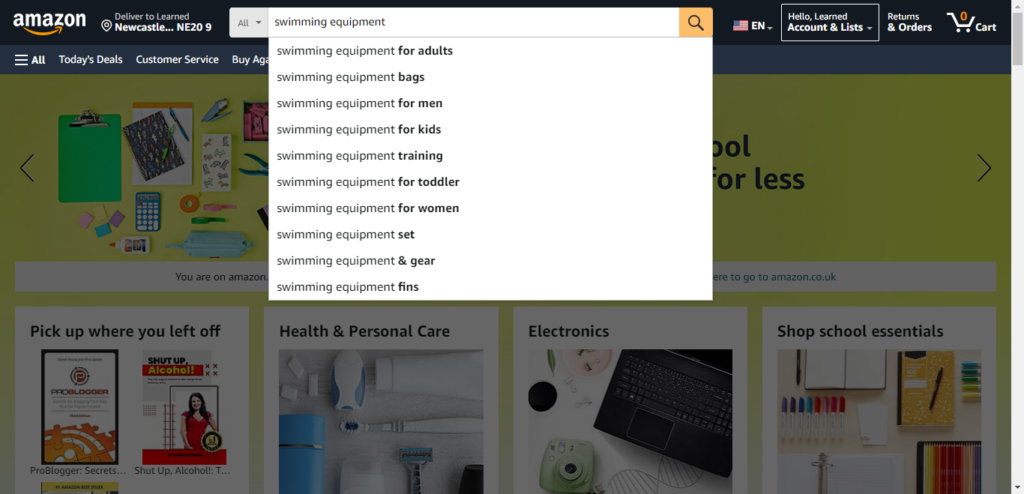
The good thing about choosing an audience you care about is that it’s usually one that you know pretty well. Finding the types of products they buy won’t be difficult.
There are two main things you want to look for:
- Demand for products
- Reasonable prices (mostly $10+)
To see the demand for these products, look at the number of reviews most of the top products have. If they have over 100, they’re pretty popular.
Obviously, if your audience is interested in potentially embarrassing products, those products won’t get many reviews, no matter how many of them are sold. So, use some common sense when evaluating whether there is a demand.
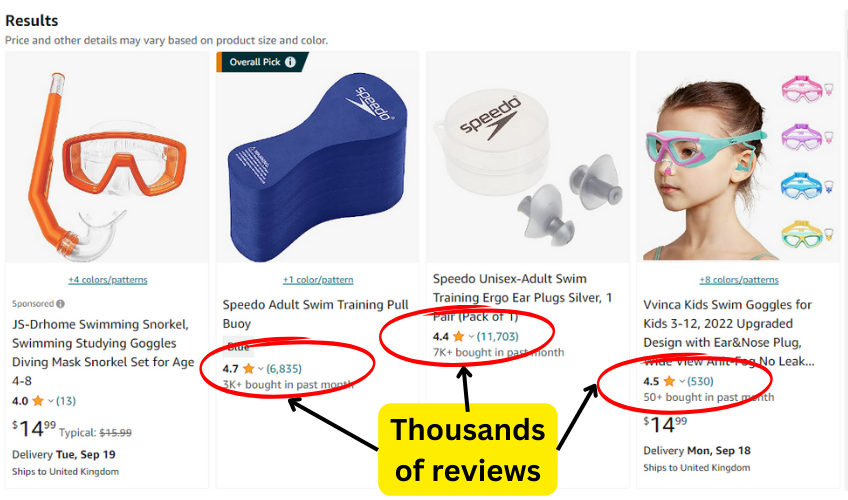
In our case, the top three products all had many reviews, and the other was an ad.
The fact that so many products on the results had a high sales volume means that there is demand for swimming equipment.
So that’s a good sign: it means swimmers will buy physical products.
Secondly, many prices start at about $10. As long as there are at least a few products with a high price and decent sales volume, it means that your audience cares more than just about getting the cheapest product possible.
Product type #2 – Informational products: We probably don’t have to tell you that most people are willing to buy products on the Internet.
This includes informational products such as e-books and courses.
Again, you can validate the demand for informational products through Amazon.
Search for your topic in the Kindle book store, or use the categories on the left side:
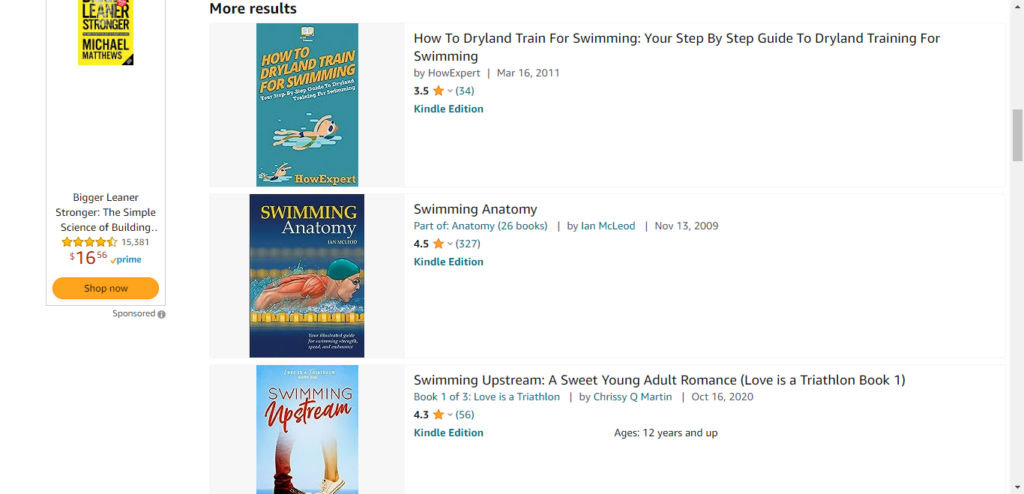
A search for swimming revealed one book with over 327 reviews and another with 34.
Typically, Kindle books don’t get as many reviews as physical products do, so even 15+ reviews are a decent indicator of a sales volume (although not great).
You’re looking for at least a few high-selling books.
You can also click on an individual book and scroll down to the product details to see its ranking in the Kindle store.
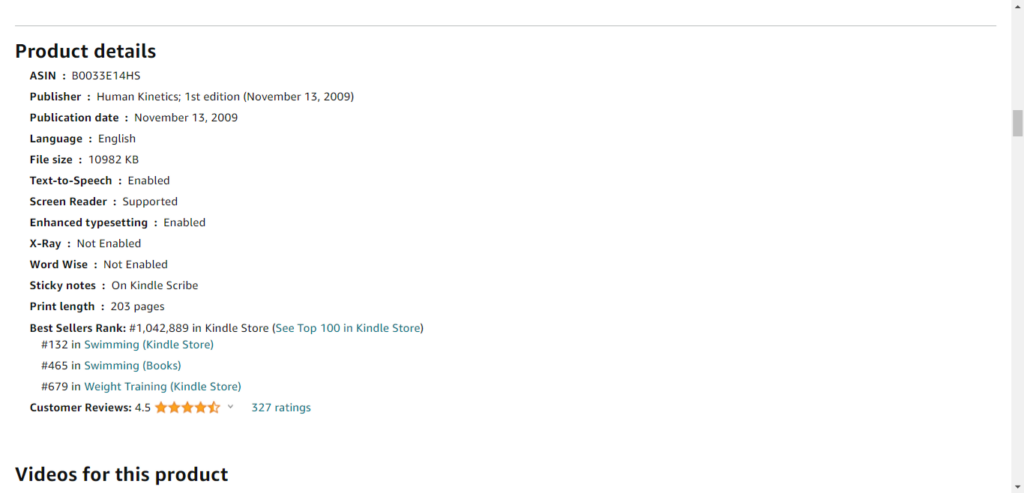
The Kindle marketplace doesn’t represent your whole audience, so all you’re looking for here is some demand.
There are tools like KD Spy for specific keywords and sales information.
If you can’t, your audience isn’t really interested in digital products.
In our swimming example, the demand is right on the edge. There’s some demand, but nothing special.
Product type #3 – Software products: Finally, web apps and tools are another type of product you should look at.
These products are usually bought by audiences interested in using the Internet.
Think of audiences such as marketers, freelance writers, designers, DJs, etc.
They all use computers for most of their work, so it’s logical that they’ll buy tools that help them do their work better.
In this case, go to Google, and search for your audience (e.g., swimming), followed by tools (or something similar).
Shockingly, there aren’t any online tools for swimmers. All the results are for things other than tools, and there aren’t even any ads (showing low commercial intent).
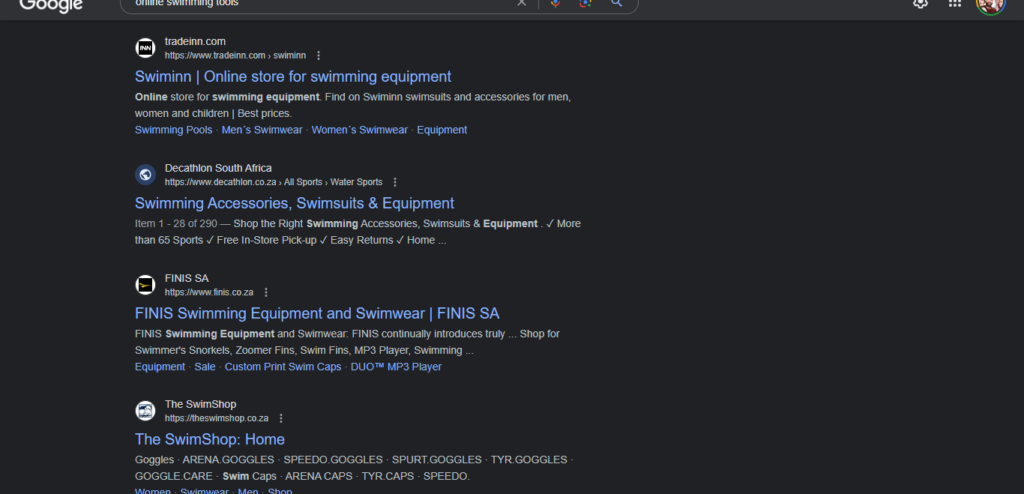
Let’s look at an example of a high demand.
Consider our audience: marketers.
One thing we know they might be interested in is keyword tracking, so we could search for keyword tracking tools:
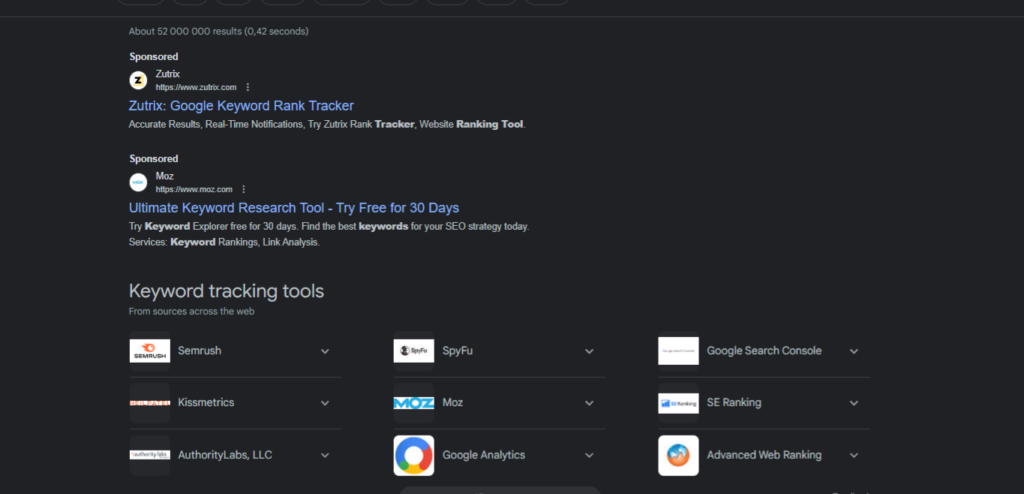
The search results are ads, and even more interesting, Google has curated a selection of the most searched keyword tracking tools, displaying each platform’s logo.
Talk about the red carpet treatment.
This is a great sign. There are ads everywhere for paid tools, which shows that there’s a big demand for these types of products.
Try searching for a few different areas of interest that your audience may have to evaluate the demand.
After validation, narrow it down: If you went through all three types of products and found no significant demand for any of them, your audience isn’t a good one. Try a different one.
If you went through all three and found one that was good, you have a decision to make. Are you potentially interested in creating that type of product down the road?
Most people are drawn to one type of product. Some people love the idea of selling a web app, while others hate it and would love to sell a physical product.
The best-case scenario is that there’s a demand from your audience in all three areas. If there is, you know that you’ll have your pick of options in the future.
Once you’ve gone through the process of validation for all your potential audiences, cross out those that won’t work, and then pick one that you’re happy to go after.
Step #2 – The audience comes first in more ways than one…
The audience comes before the product, but understanding the audience also comes before ever making any content.
Unless you understand your target audience really well already, take some time to research some basic demographic and psychographic information.
We’ll show you how —
Start with demographics: As you might know, demographics are statistics that can be used to describe a person or group.
The most common ones are:
- location
- age
- gender
- income
- education level
- religion
- ethnicity
- marital status
- number of children
Your goal is to define any relevant demographics for your audience.
If you are looking at an audience interested in high heels, then gender is probably important. However, gender is unimportant for other audiences, such as marketers or chefs.
Evaluate which parameters are relevant to your audience.
One way to find some of these demographics is with Google Analytics.
Search for any big sites in the general niche your audience is in using the top search bar.
That will bring up quite a few useful estimations, including gender, education, and browsing location:
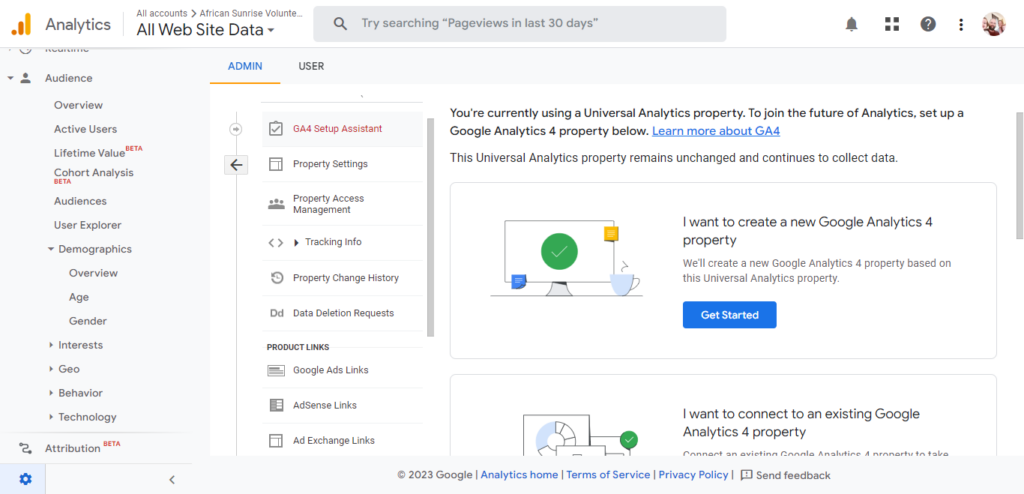
Alternatively, head over to the Adwords Display Planner.
The purpose of this is to try to define a reader’s persona so that you can come up with content ideas that they’ll be interested in later on.
Continue with psychographics: This data is about your audience’s thoughts and beliefs.
For example:
- Why do they want to learn about (your niche)?
- How important is (your niche) to them (i.e., is it a hobby or part of their job)?
- How do they like to learn (e.g., video, text, audio, etc., and on what type of device)?
- What common questions do they have about (your niche)?
- How knowledgeable are they about (your niche)?
You should try to answer each of those questions with a concise description.
Remember, the purpose is to build a profile of the way the people in your target audience think.
It’s very important and leads to the next step: positioning.
Step #3 – (Positioning) How you can eliminate your competitors
After step #1, you’ve picked an audience that is willing to spend money on products.
That means you will have competition.
Don’t be scared.
You can still be successful; it just depends on your positioning.
What’s positioning? Positioning is a way to make your audience associate you and your brand with a particular aspect of their interests.
An example will clear things up.
Let’s say you wanted to target social media marketers.
There’s only one problem…
You’ll have difficulty building an audience if you write about social media tips and techniques.
Why? Because people already associate social media marketing with sites such as Quick Sprout and Social Media Examiner.
If they want to learn about social media, they’ll stick with the big sites they’re familiar with.
But those sites have weaknesses (gasp!). In fact, all authoritative sites have weaknesses.
While they might appeal to a large percentage of the overall niche audience, they can’t appeal to everyone.
For example, there are many people who like short, quick tips about social media marketing.
Considering the typical Quick Sprout post is at least 4,000 words, it doesn’t really work for them.
Others want social media marketing help, but only on certain types of networks, e.g., image-based networks such as Pinterest.
Obviously, all the big sites cover pretty much all the major networks, so it’s not exactly what these people are looking for.
Do you see where we’re going here?
There are many ways of standing out to a specific portion of the audience, which is more than enough to get you started.
You position yourself to appeal to a specific audience by creating content in a way that they want, but no one else is providing.
For example, you could position yourself as the go-to person for quick tips about Pinterest marketing.
If someone’s interested in quick tips about Pinterest marketing, they aren’t coming to Quick Sprout—they’re going to you.
The beautiful part is that they will LOVE your content once they find you (we’ll show you how later). Since you’re producing content specifically for them, they will think you’re reading their minds.
This is how you get loyal readers who not only read your content but help you grow your audience.
How to find your position: To figure out how to position yourself against the competition, fill out something called a positioning matrix.
A positioning matrix is just a simple plot.
You specify something to measure on both the X and Y axes. Then, you plot all of your competitors on it. This makes it really easy to see where there’s a gap.

Step #1 – Identify differentiators: First, brainstorm all the things that your audience might find valuable.
A differentiator is anything that a reader may like or dislike.
For example, some readers prefer advanced content, while others want beginner content. The differentiator here is a difficulty.
Here are some common differentiators; see which ones apply to your audience:
- Difficulty: Easy vs. Hard
- Detail: Brief vs Step-by-step
- Type of content: Mainly text vs. Lots of images vs. Rich media (videos, gifs, etc.)
- Experience level: Beginner vs. Professional
- Cost: Cheap vs. Expensive
- Length: Short vs. Long
Those are the most common, but there are others, so consider them.
Step #2 – Identify competitors: Your next step is to list your biggest competitors.
This is pretty simple, especially if you know the niche already.
If not, just Google:
Top social media marketing blogs.
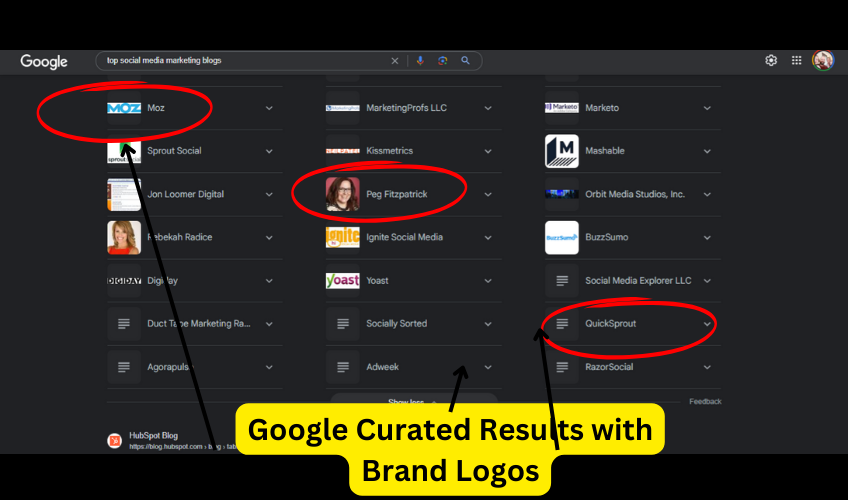
This is a relatively new feature from Google, where it curates the most suitable results and displays branding.
Ideally, you want a list of about 10 competitors — Google will
Step #3 – Plot your competitors: Now, you need to pick two of the differentiators you identified before.
Then, create a basic matrix with those differentiators as the axis labels. You can draw it by hand, create it in a spreadsheet or Paint, or do it any other way that works for you.
Here’s what it should look like:

You need to review your competitors’ lists individually and determine how they fit on this scale.
For example, Quick Sprout posts are very long, so they’ll fall near the top of this plot. On top of that, our posts are written on somewhat advanced topics, so Quick Sprout also falls near the right side.
You want to plot all of your competitors on the matrix:

Hopefully, you’ll see at least one big gap.
In this case, you could create either long or short content for beginner marketers.
And now you have your position.
Sometimes, you won’t see any gaps. Then what?
Then, you pick a new set of differentiators and repeat the process. You can find an open space for just about any large audience.
Step #4 – Kickstart your audience
Now that you’ve defined your positioning, you’re ready to start blogging, right?
Hold on a second!
If you start blogging, you won’t have any readers (unless you have a large personal network).
There’s no point in blogging unless you can drive people to your posts.
While you can use promotional techniques to do that, they’re much more effective if you already have readers coming to your content.
So, what can you do?
The answer is to go where your audience hangs out on the web and get them to visit your website.
Then, you have two options:
- Write one or two amazing blog posts so that they subscribe to your email list
- Send them to a landing page offering them an awesome lead magnet
The basic idea is to get at least a few hundred regular readers and then start blogging more frequently on your own site.
That way, your readers can help promote your content, and you’ll grow much more consistently.
In this phase, we’re looking for high-growth tactics. How can you get hundreds of visitors and subscribers as fast as possible?
There are two main proven strategies.
High growth tactic #1 – Guest-posting: You determine which blogs your readers frequent and guest-post on them.
But don’t just post about any topic. Post about a topic you would write about on your blog (remember your positioning).
The people who love that post are the ones you want to subscribe to your site.
We’ve written extensively about guest-posting effectively, so start with this guide:
High growth tactic #2 – Paid advertising: If you have money to invest and you want to save time, go with paid advertising.
It’s not too hard to get subscribers for $1-2 each once you practice a bit, which means you can build a solid following of 500-1,000 readers for $500-2,000, which isn’t too big of an investment.
The great thing is that you can do this in under a month.
Step #5 – How to grow your audience by 5-15% every month
Now that you have an audience of a decent size, you can grow it just by posting on your own blog.
5-15% isn’t a lot, but it adds up quickly due to compound growth.
Here’s what it looks like if an initial audience of 500 grows by 10% every month for two years:

After two years, your new blog will have about 5,000 readers. That’s a solid audience.
And that’s a pretty conservative estimate. You might grow faster than that, but this is an easy minimum growth target that you can almost guarantee.
So, aim for 5-15%.
How do you do it?
It’s really not that complicated. There are three parts to it.
Part #1 – Come up with content ideas: Now that you need to write a lot of content, you need to build a content bank of great ideas for your audience.
Everything is about consistent growth here. That’s why you want a content bank.
If you’re coming up with ideas as you need them, it’s easy to procrastinate or skip publishing content. It’s also difficult to have any connection with your other posts.
So, come up with as many good ideas as possible—ideally enough for at least a few months. Use these resources if you get stuck:
Part #2 – Create a sustainable content schedule: Once you have content ideas, you need to figure out when you’ll write and post them.
Again, you want to do this on a consistent basis.
We post on Quick Sprout multiple times a week.
That’s a pretty aggressive posting schedule.
If you’re worried that you’ll be stressed out and might not be able to produce that much content, go twice a week or maybe even once a week.
Whatever you choose, just be consistent, and you’ll grow over time.
It’s important that you put these posts into a content schedule:
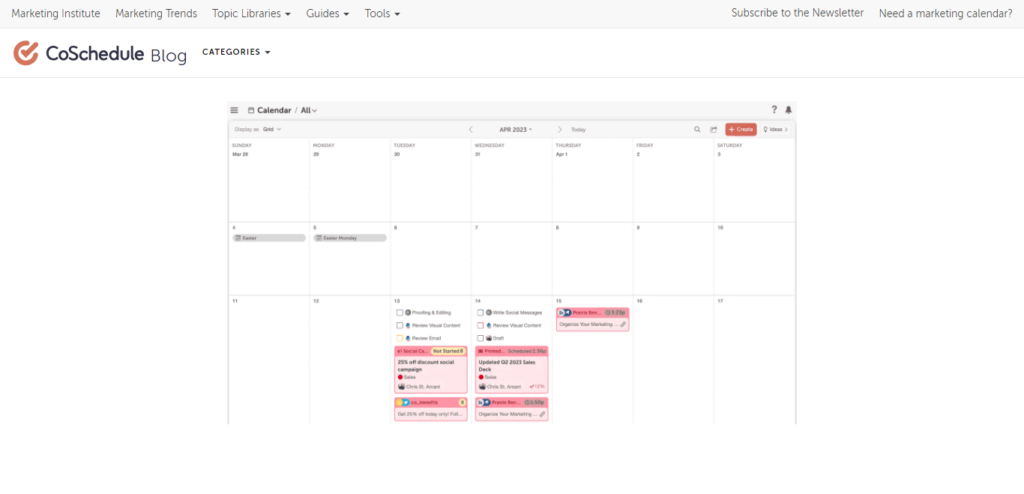
It doesn’t have to be anything fancy.
You can use a simple spreadsheet to map out your schedule.
Part #3 – Figure out how you’ll stay in touch: We’ve alluded to it already. You need a way to stay in touch with your audience.
No matter how great your content is, people will forget about you if you don’t remind them.
The best way to do it, by far, is email marketing. Start building an email list of subscribers from day one.
You can also decide if you’d like to build up your followers on a social media platform as a secondary communication means, but that’s optional.
It might help you grow a bit faster, but you’ll be okay if the email list is in place.
Step #6 – Building products your audience begs you to buy
Now you’ve got an audience of at least a few thousand subscribers.
They love your content, and you’ve given them a lot of value up until now.
Now, you can use your audience to generate product ideas they’ll love.
No one will understand your audience that you’ve built better than you. This is how you’ll create a better product than anyone else can.
On top of that, you’ve built a relationship with your audience, and they will be happy to give your product a chance and give you valuable feedback.
How do you come up with product ideas this way? There are three main options.
Option #1 – Pitch product ideas to your list: There’s a good chance that you can come up with 5-10 good product ideas at this point in your business.
The simplest way to see if they’re actually any good (i.e., something people will buy) is to send a pitch to your subscribers to see if they’re interested.
Bryan Harris at Video Fruit posted an amazing behind-the-scenes write-up about how he did this very thing.
We’d recommend bookmarking that post for later reading, but here’s the gist of it.
He created a basic proposal for a product—a teaching course:

He then sent it, but not to everyone on his list—he sent it to just 50 subscribers.
Why send something to your whole list if it could end up sucking?
He sent those 50 people this simple email:
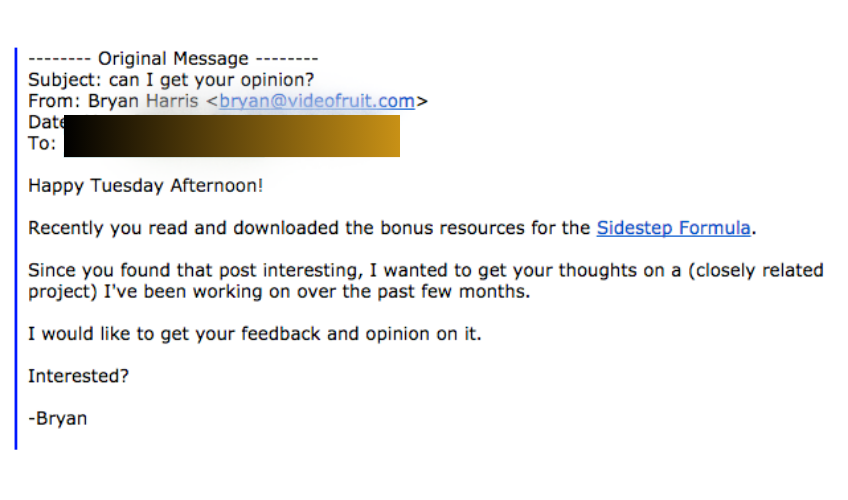
Remember that you can do this for multiple product ideas to different groups of 50.
It’s a good sign when it goes well, and your subscribers are interested in pre-ordering the product.
You can then send it to slightly larger groups to verify that you have a winner.
In total, he sent the product—that he ended up creating—to a group of 50, then 75, and then 100.
Out of those 225 people, 39 pre-ordered the course.

When Bryan sold the course to the rest of his list, they loved it just as you’d expect.
Option #2 – Survey your readers: Surveys can also be useful to gain insight into your readers’ biggest problems.
Once you know their problems, you can propose different products as solutions to those problems and see which ones they’d want to buy.
Surveys alone won’t often reveal great product ideas, but you should use them with options one or three to gather extra data.
Option #3 – Pay attention to comments: Sometimes, your readers will tell you what they’d pay for.
For example, in a comment on one of our posts about using videos in marketing, Jessica said that she’d be willing to spend money to solve her problem of not knowing how to create professional videos:
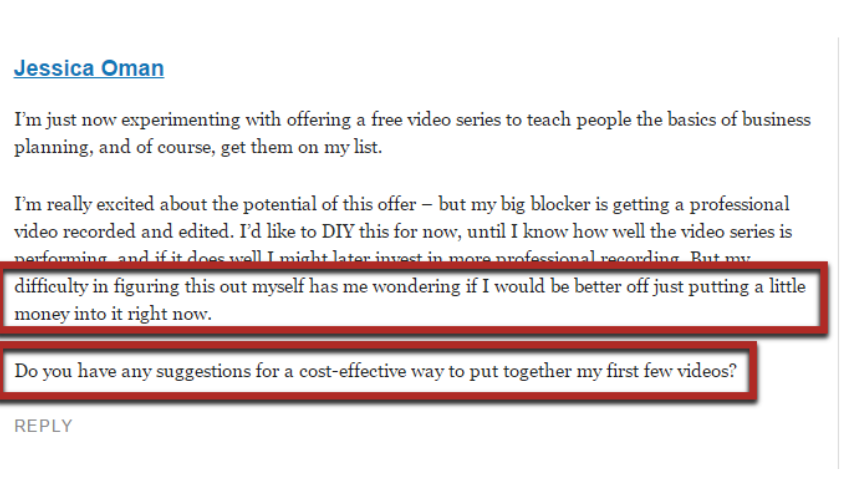
Boom!
Product idea right there. We could create a step-by-step course that shows customers how to create an amazing video.
Pay close attention to comments and emails that you get from subscribers. Once you start to get five+ about the same topics with the mention of spending money for a solution, offer the solution yourself!
Step #7 – Turning readers into buyers
Once you have your product, you must sell it to your audience.
You don’t really need a fancy sales pitch because you’ve built a relationship with your audience over time. That’s one of the biggest benefits of this method.
However, besides a simple email sales pitch, we recommend webinars to sell expensive products.
Adweek has an extensive webinar library that’s worth your time.
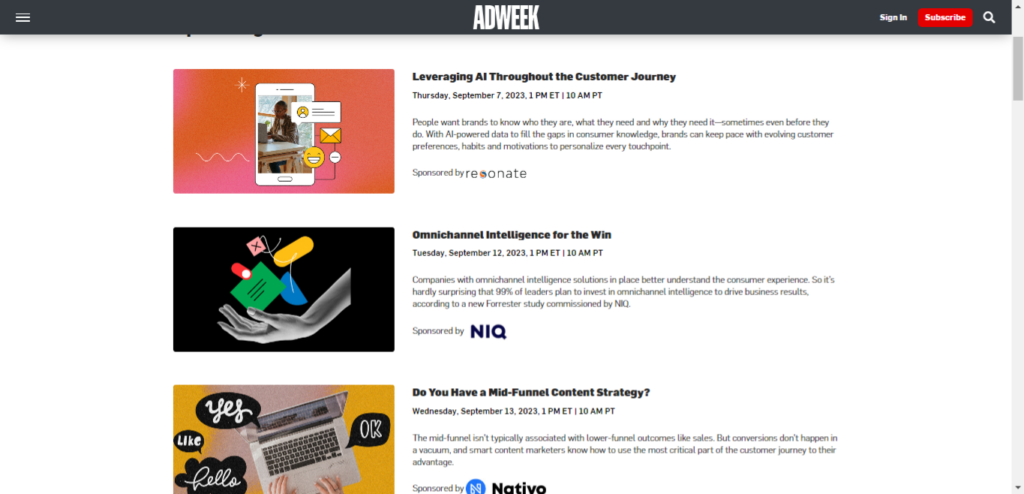
The basic idea is to teach people about a topic related to your product. Ultimately, you do a quick, no-pressure pitch of your product with some offer.
You can get conversion rates of around 20% with a good webinar, which is insane.
Conclusion
You can create a product and then find customers to sell it to.
Or you can flip that model on its head and build an audience first.
When you build an audience, you build relationships that allow you to learn about your audience and create products you know they’ll love.
That’s how you minimize your chances of failure while getting great conversion rates and instant sales on any products you create.
We’ve given you the complete seven-step guide to building a business by starting with your audience, but it’s up to you to take action now.
